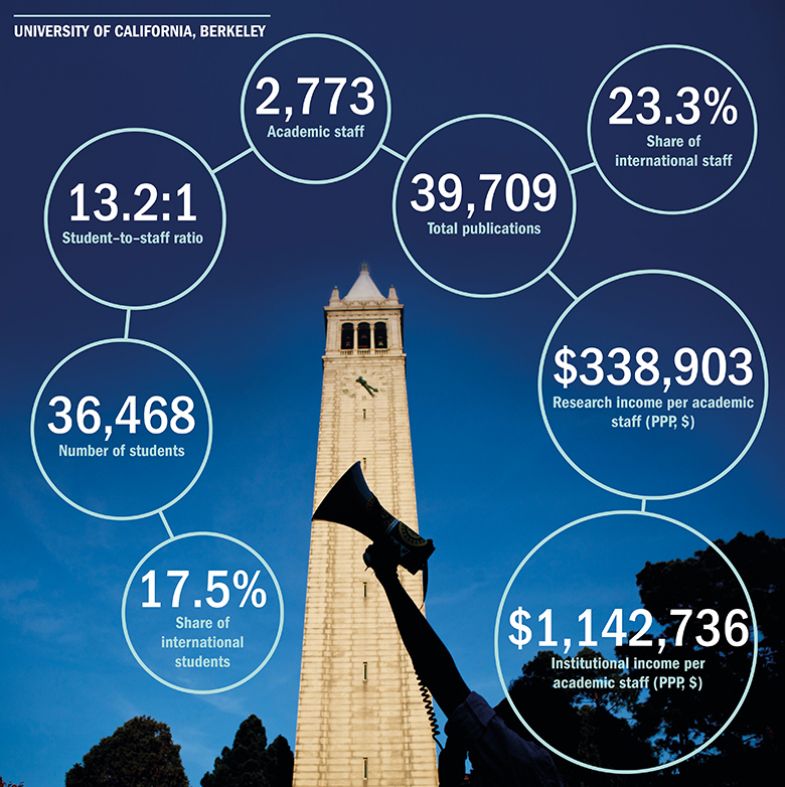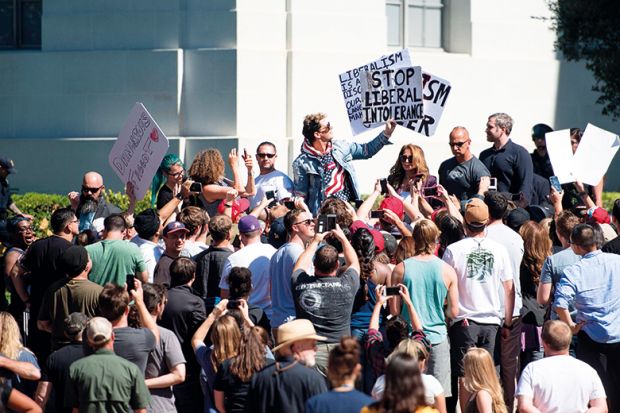Browse the full results of the World University Rankings 2019
In my first year as chancellor of the University of California, Berkeley, I decided that four tasks were essential: creating an authentic narrative that put the present in the context of Berkeley’s past and future; building community and a real sense of belonging; determining strategic priorities; and creating a new financial model for the campus.
People in organisations of any sort use narratives to understand and convey identity and trajectory; we are a storytelling species. When you lead an institution, you step into this narrative, which I often imagine as a river. It has had many chapters before you enter and will have many more after you leave, but for a period of time you have the opportunity not only to shape its course, but also to shape a common understanding of that course – a task that requires identifying those elements of our shared history most telling for where we aspire to go. Succeeding in that task is essential for any complex organisation that hopes to marshal its human resources in pursuit of salient objectives and priorities.
This year, Berkeley is celebrating its sesquicentennial. It would be easy to tell a triumphalist story, full at once of nostalgia and pride, but such a story wouldn’t be true to the current moment, at which the university is inventing a new financial model – a hybrid of public and private – to compensate for the reduction in the generous state funding on which we relied for more than a century. Indeed, such a story would probably not be true to any moment because robust institutions such as Berkeley evolve constantly, driven by resilience and imagination.
Stories represent communities to themselves, and building community in urban universities as large and as diverse as Berkeley is both challenging and essential. Like a city, we are many neighbourhoods – neighbourhoods defined by academic discipline, by economics, by politics. We are living in a divisive time in the US right now, and campuses are not immune to the forces of division and polarisation. Indeed, as we have seen, an iconic campus such as Berkeley can quickly become an attractive stage for larger political conflicts.
For our university, the defining events of the past year revolved around free speech. We began the autumn with two free speech “events” – a speech by the conservative pundit Ben Shapiro, and a “free speech week” planned by the right-wing provocateur Milo Yiannopoulos. It was both a legal obligation and a reputational necessity that the university do everything it could to enable the speeches to take place. Shapiro’s did; Yiannopoulos tried unsuccessfully to provoke the university into cancelling his event in pursuit of his desired narrative-cum-headline: Berkeley, home of the free speech movement, denies free speech. We called his bluff, the charade collapsed and his student hosts cancelled the event. Together, our words and deeds succeeded in supporting a story both simple and true: Berkeley’s commitment to freedom of expression is unwavering.
Despite the “success” of both of these events, they were deeply divisive to the community. Many students, and even some faculty, were angry and troubled that the university would host speeches that violated deeply held values – inclusiveness, diversity, equity. The heavy police presence on which we relied to ensure that the events went forward was disruptive to the normal operations of the campus and disturbing to many people. In order both to build and to repair a shared sense of community, I created multiple occasions in which the campus could engage the issue of free speech, including a Free Speech Commission, which held hearings and made a set of recommendations for how the campus might better reconcile its free speech guarantees and protections with our values as a community.

Despite the immediate challenges presented by the free speech crisis, I knew that it was critical to not lose sight of long-term objectives that could be met only by determining strategic priorities for the campus. Strategic planning in universities is often designed as a grass-roots, bottom-up process, in which ideas are solicited from the entire community and a high-level committee chooses among them. I felt that such a process, in the context of our budgetary challenges, would result in both cognitive dissonance and considerable disappointment. I therefore decided to structure the process around four strategic questions:
- What are signature initiatives in which Berkeley can invest that would have the most consequence to our state, our country and our world?
- What investments would have the greatest impact on the quality of student experience?
- What enrolment strategy will serve us best in the next decade?
- What is a new financial model for the campus?
I repeatedly insisted that the plan had to fit on a place mat. The process itself was energising, inspiring people to think forward about values, principles and aspirations. In and of itself, it was shaping our narrative. We are now deep in the work of planning implementation; we have a compass for our investments and decisions. We have a powerful, forward-looking story to tell.
Fundamental to our strategic plan for the campus is a new financial model. Because of the significant drop in funding from the state, Berkeley must multiply and diversify its sources of revenue, while remaining true to its public mission and ethos. We are concentrating on six sources of enhanced revenue: non-degree enrolment, particularly in continuing education and summer classes; new self-supporting professional master’s programmes (without a state subsidy); increased monetisation of intellectual property; increased contract and grant activity; increased monetisation of real estate; and philanthropy. All these strategies depend for their success not only on getting the incentives right for the department in which the activity takes place but also on figuring out how to use a portion of the increased revenue to support the greater good – services on which the campus depends, such as the library or IT infrastructure, that do not create revenue.
Creating a new financial model requires not only the conceptual work involved in its design but also much work on culture change, as we encourage our departments to be more entrepreneurial, as we think about new models of academic programme delivery, as we reshape our philanthropic strategy.
People have long talked about the California idea in higher education; the University of California model has been influential throughout the world. As we adapt both to the increasing demand for a University of California education (six of UC’s 10 campuses received more than 100,000 applications this past year) and to a very different funding model, Berkeley will continue to embody the California spirit – diverse, inclusive, entrepreneurial – as it continues to empower engaged thinkers and citizens to change our world. That is a story, a narrative, that must be told.
Carol Christ is chancellor of the University of California, Berkeley.
后记
Print headline: Our authentic and ever-changing story




